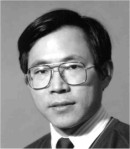|
Plenary
Lecture
Partition and Propagation of Delamination in Fibre
Reinforced Composite Laminates

Professor Simon S. Wang
Department of Aeronautical and Automotive
Engineering
Loughborough University, Loughborough
Leicestershire, UK
E-mail:
s.wang@lboro.ac.uk
Abstract: Fibre reinforced composite laminates are
very attractive to manufacturers of light weight
structures in several industrial sectors, such as
aeronautical, automotive and ship industries. However,
delamination has always been a major concern in their
applications due to the possibility of caused
catastrophic structural failures. Consequently, their
competing ability is considerably compromised against
advanced metallic alloys. To improve the situation, it
is of paramount importance at present time to understand
the mechanics of delamination and its propagation. This
lecture focuses on this topic. Analytical, numerical and
experimental studies are reported.
In our study, delamination is regarded as a mixed mode
fracture and strain energy release rate is considered as
a quadratic form of positive definite of local crack tip
forces and moments. Two sets of orthogonal pure modes
are discovered. One set is proved to be a complete basis
and is used to partition any mixed delamination mode.
Although the individual pure modes in a pure pair are
orthogonal, they still interact to each other in a
stealthy way which results in a net zero energy change
within the pair. However, the stealthy interaction
results in energy flow between the orthogonal pure modes
which changes mode energy partitions. Numerically,
laminar interfaces are modelled by using imaginary
springs. Strain energy release rates are calculated by
using crack closure technique. An XFSM is developed
based on a layer-wise theory to study the propagation of
delamination in generally anisotropic laminates under
compression. Extensive analytical, numerical and
experimental studies are presented The results show that
unstable propagation is often caused by mode I
delamination whilst mode II delamination often leads to
stable propagation. Multiple delaminations interact with
each other and considerably change the propagation
behaviour.
Brief Biography of the Speaker:
Simon S. Wang received his BSc and MSc education from
Tsinghua University of China between 1978 and 1985. He
obtained his PhD from Birmingham University of UK in
1990 and worked as a post doctoral research fellow in
the same institution from 1991 to1996. He joined
Loughborough University of UK in 1996 as a lecturer and
became a senior lecturer in 2003. He is now a concurrent
professor of Hebei University of Engineering of China.
He is the author of over 100 academic papers in
international journals and conferences. He has been
frequently invited to give plenary and keynote
presentations in international conferences and research
lectures in prestigious research institutions.
|
